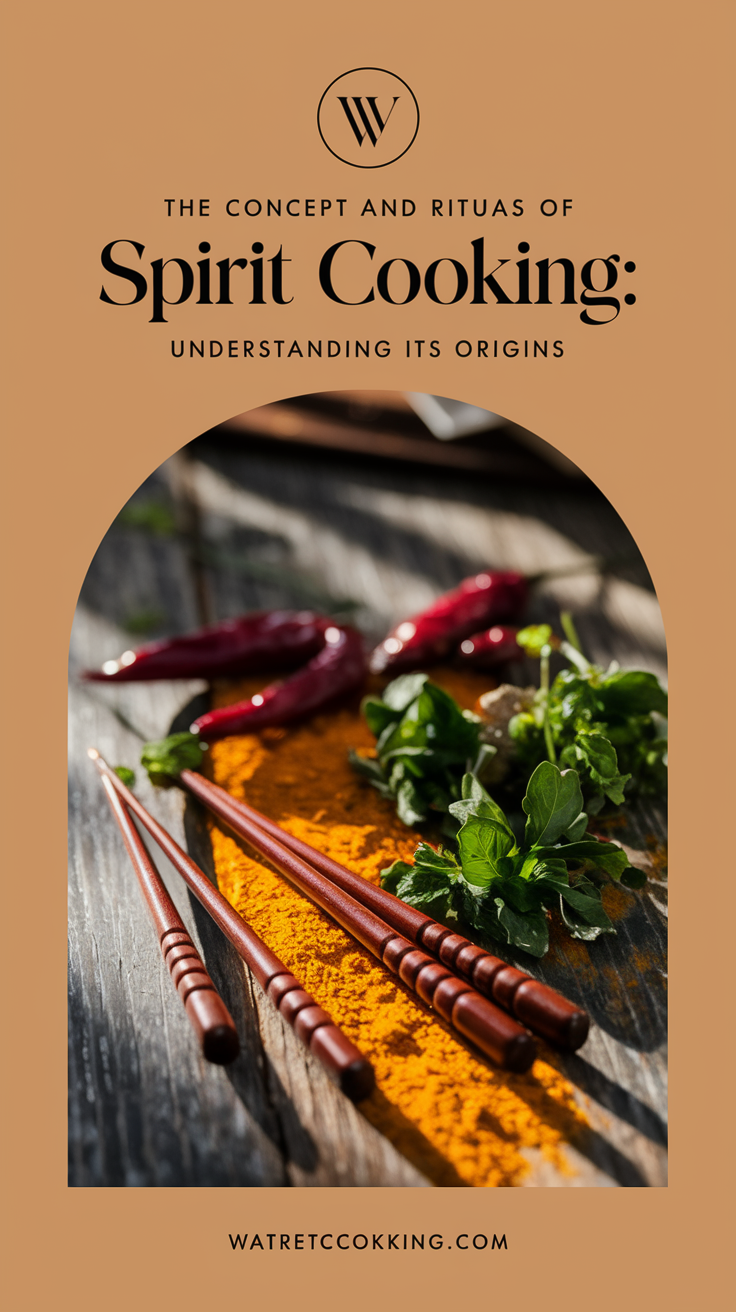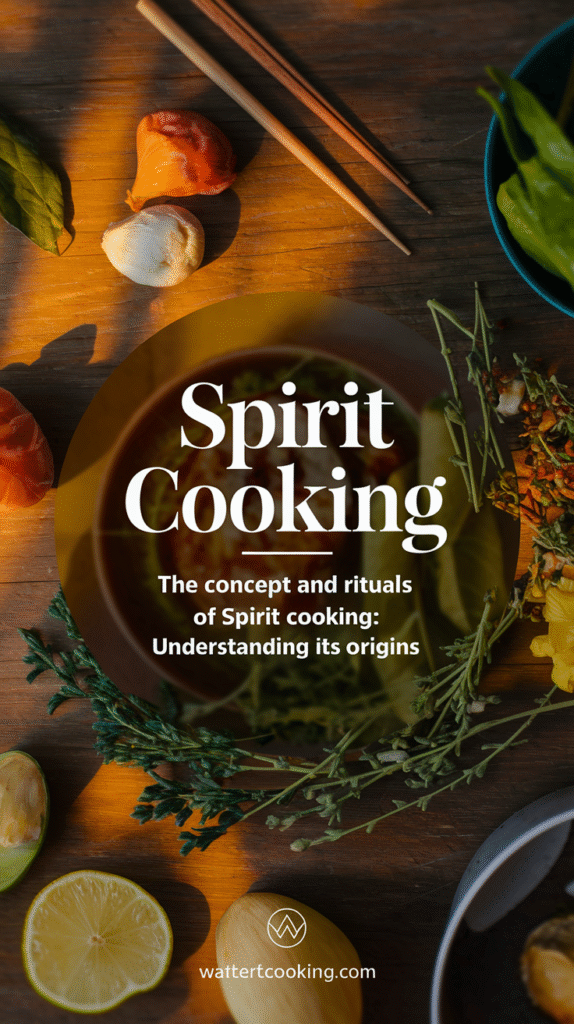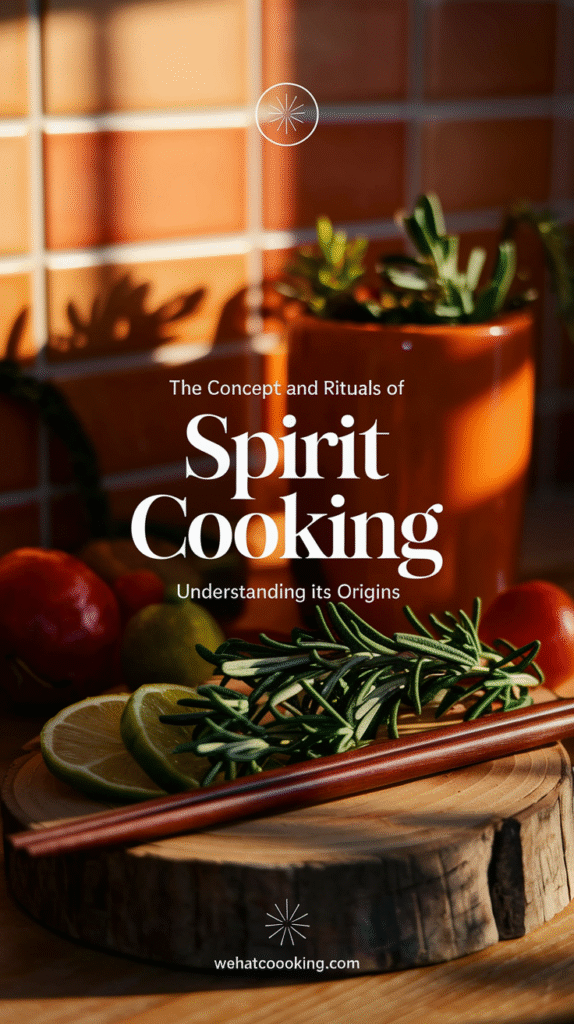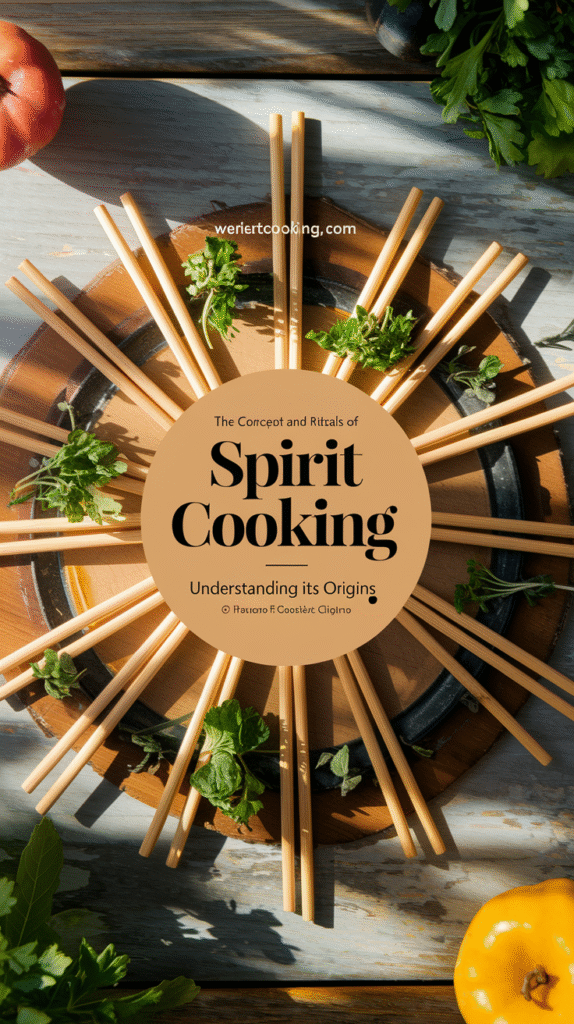The world of art and ritual is filled with complex traditions and practices. One such intriguing practice is spirit cooking. This concept has been a focal point of discussion and controversy, especially in the realm of contemporary art. Understanding its origins and rituals can help demystify its significance.
Spirit cooking can be traced back to the works of performance artist Marina Abramović. This form of art combines the elements of performance, visual aesthetics, and ritualistic practices. It is designed not only to provoke thought but also to evoke deep emotional responses from its participants and audience.
The Historical Context
The origins of spirit cooking are deeply rooted in ancient cultural practices that involved ritualistic and symbolic acts. These rituals were often linked to belief systems about life, death, and the afterlife. Early instances of spirit cooking reflected an intention to transcend the physical world, inviting participants to explore consciousness and the unknown.
As Abramović explored these themes in her performances, she infused them with her personal experiences, cultural heritage, and influences from various philosophies. Grounded in a tradition that encompasses both the visual and the visceral, spirit cooking acts as a conduit for expressing the human condition.
Core Elements of Spirit Cooking Rituals
At its core, spirit cooking combines various elements that encapsulate its essence:
- Food as a Medium: Ingredients are often tied to symbolic meanings, representing various aspects of life and death.
- Ritualistic Actions: Participants engage in specific actions that can include cooking, chanting, or drawing, creating a multi-sensory experience.
- Intention Setting: Each ritual usually begins with the setting of an intention to guide the experience, focusing the energy of those involved.
- Performance Art: The act itself is often performed live, drawing in an audience, further blurring the lines between participant and observer.
The interaction with food—as both sustenance and symbol—plays a critical role in these rituals. The food can resonate on various levels with participants, acting as a metaphor for life, nurturing, and transformation. It raises questions about purity, consumption, and the cyclical nature of existence.
The Controversy Surrounding Spirit Cooking
As spirit cooking entered the mainstream conversation, particularly due to social media, it garnered both praise and criticism. Some regard it as an avant-garde expression of art, while others view it through a controversial lens, suggesting it represents dark themes or occult practices. What often underlies this criticism is the misunderstanding of the intentions and cultural significance behind the rituals.
Many artists, including Abramović, rely on the audience’s emotional response to provoke dialogue about themes that may be uncomfortable but essential for growth. The conversations sparked by spirit cooking often address broader societal issues such as morality, identity, and transformation.
The Modern Interpretation of Spirit Cooking
Today, spirit cooking continues to evolve, influenced by modern society’s values and cultural shifts. Artists and practitioners are utilizing these rituals to foster community, heal through shared experiences, and explore personal narratives. Here’s how contemporary practices are reshaping spirit cooking:
- Collaborative Experiences: Many artists now invite audiences to participate actively, creating a spacious ground for shared exploration.
- Digital Engagement: Online platforms have expanded the reach of spirit cooking rituals, allowing for interactive experiences beyond physical confines.
- Educational Workshops: Some practitioners offer workshops to teach the historical and cultural background of these rituals, promoting an understanding of their significance instead of fueling misconceptions.
If you’re interested in learning more about spirit cooking, additional information can be found at Marina Abramović’s official website. Exploring her insights can provide further depth to this unique art form.
Through understanding spirit cooking, we can appreciate how art can challenge our perceptions, provoke discussions, and reflect our deepest desires to connect spiritually and culturally. As the practice continues to evolve, it invites all of us to engage in the rich tapestry of human experience.
Artistic Expression in Spirit Cooking: The Role of Creativity
Art is a powerful medium that allows people to express their deepest thoughts, emotions, and beliefs. In recent years, the term “spirit cooking” has emerged, connecting the realms of art and the mystical. This practice, pioneered by artist Marina Abramović, is not only a form of artistic expression but also a provocative exploration of the body, spirit, and human consciousness.
Spirit cooking involves the use of food, ritual, and creativity to create an experience that goes beyond the physical. It challenges traditional notions of art by suggesting that the creation and consumption of food can become a form of spiritual interaction. Here’s how creativity plays a vital role in spirit cooking:
Exploration of Materials
At the heart of spirit cooking is the exploration of unconventional materials. Artists often utilize various ingredients and objects to create unique art experiences. Commonly used materials include:
- Beeswax
- Blood
- Salt
- Herbs
These components are not merely used for their aesthetic value but carry deep symbolic meanings. For instance, salt can symbolize purification, while blood may represent life and death. When combined creatively, these materials foster a dialogue around the human experience.
Performative Aspects
The performative nature of spirit cooking makes it stand out as a vivid form of expression. Participants are often encouraged to engage directly with the work, fostering a sense of connection and intimacy. This interactive dimension adds layers to the experience, allowing for:
- Self-reflection
- Community bonding
- Transcendence of everyday life
By inviting viewers into the process, spirit cooking becomes a communal event, lifting the individual experience into a shared journey of creativity and understanding.
Ritual and Meaning
The integration of ritual in spirit cooking enriches the artistic expression. Rituals often hold cultural or personal significance, imbued with history and narrative. Here’s how ritual enhances creativity in this practice:
- It infuses the artwork with deeper meaning.
- It provides structure and intent to the creative process.
- It connects the artist, the participants, and the audience.
The impact of ritual can transform the act of cooking from a mundane task into a sacred experience, allowing one to explore their spirituality through creativity.
Interdisciplinary Approach
Spirit cooking does not exist in isolation. It intersects with various fields such as psychology, philosophy, and anthropology, challenging conventional boundaries. This interdisciplinary approach encourages a fusion of ideas, allowing creativity to flourish in unexpected ways. Some key influences include:
- Psychological insights into the human psyche
- Philosophical inquiries into existence
- Cultural heritage and identity
This blending of disciplines creates an environment ripe for innovative expression, pushing artists to explore new dimensions of creativity.
Connection to the Audience
The ultimate goal of spirit cooking is to establish a profound connection with the audience. By engaging them in the creative journey, artists can evoke a range of emotions and provoke thought. This immersive quality is crucial for transforming viewers into participants. Ways to create this connection include:
- Encouraging audience participation
- personal stories and experiences
- Fostering open discussions about interpretation
This dialogue not only energizes the event but also allows individuals to take ownership of the experience, making it memorable and impactful.
Artists like Abramović have shown that spirit cooking can be a transformative experience that intertwines creativity, spirituality, and community. The role of creativity in this practice is not merely about creating art to be displayed but about cultivating an experience that reverberates on emotional and spiritual levels. Through innovative use of materials, the incorporation of rituals, and a deep connection with the audience, spirit cooking stands as a testament to the power of artistic expression.
If you’re interested in learning more about spirit cooking and its artistic implications, consider exploring resources such as Marina Abramović’s Official Website or ARTnews for deeper insights into contemporary art and performance.
The Controversy Surrounding Spirit Cooking: Myths vs. Reality
Spirit cooking has become a hotly debated topic, often linked with conspiracy theories and misunderstood practices. The term, initially coined by artist Marina Abramović, refers to a performance art piece that incorporates elements of ritualistic and symbolic cooking. Despite its artistic roots, spirit cooking has been the subject of numerous controversies that blur the lines between myth and reality. Let’s delve into the truth behind spirit cooking, separating fact from fiction.
Understanding Spirit Cooking
At its core, spirit cooking draws from Abramović’s exploration of the body, spirit, and the act of creation. The performance entails the use of unconventional cooking methods, often accompanied by the artist’s provocative instructions, which can include elements like blood and bodily fluids symbolically representing life force and energy.
Common Myths About Spirit Cooking
There are several myths surrounding spirit cooking that often misinform the public:
- Myth 1: It is a ritualistic form of witchcraft. Many people believe that spirit cooking is a form of occult practice. However, Abramović has clarified that it is primarily an interactive art piece that engages participants in a dialogue about perception and consciousness.
- Myth 2: Celebrities are involved in dark rituals. The association of spirit cooking with high-profile figures, especially in the realm of politics and entertainment, has fueled conspiracy theories. Often, these rumors are based on cherry-picked images or out-of-context statements.
- Myth 3: Spirit cooking promotes harm or violence. In reality, the performance intends to provoke thought and reflection, rather than harm. The theatrical nature of the piece often leads viewers to misinterpret its intentions.
The Reality of Spirit Cooking
The actual practice of spirit cooking can be viewed in various ways:
- Artistic Expression: As an artist, Marina Abramović utilizes spirit cooking to challenge and engage audiences, pushing them to confront their perceptions of food, body, and ritual.
- Symbolic Engagement: The ingredients and actions within spirit cooking are often metaphors. For instance, using bodily fluids symbolizes the connection between life and art, pushing boundaries of what art can mean.
- Cultural Reflection: The work invites discussions about bodily politics and the taboo surrounding food and consumption.
Connection to Conspiracy Theories
The rise of spirit cooking in the public eye coincided with political controversies, particularly during the 2016 U.S. presidential election. The leaked emails from John Podesta, Hillary Clinton’s campaign chairman, included a reference to spirit cooking, leading conspiracy theorists to concoct elaborate narratives about secretive cults and rituals. These theories, ran rampant online, often lack credible evidence but capture the imagination of many.
Exploring the Impact of Misunderstanding
The misunderstandings surrounding spirit cooking have had impactful consequences:
- Art and Expression: The fear of association with dark practices can hinder artists from exploring avant-garde themes and challenging societal norms.
- Public Perception: Misinformation can shape public perception of art and its practitioners, leading to unwarranted scrutiny or judgment.
- Community Relations: The conflation of creative practices with criminal or sinister activities can impact cultural communities and their ability to share authentic expressions.
Engaging with Spirit Cooking
To engage with spirit cooking in a meaningful way, consider exploring Abramović’s work through credible sources. Museums and galleries often provide educational resources that can deepen your understanding of performance art. If you wish to learn more about the intersection of art and ritual, check out the official Marina Abramović website or look into The Art Newspaper for critical insights and exhibitions featuring her work.
Ultimately, spirit cooking embodies a complex interplay of art and meaning, frequently shrouded in misunderstanding. By differentiating between myths and reality, you can gain a deeper appreciation for the intentions behind this provocative art form.
How Spirit Cooking Influences Modern Art and Culture
Spirit cooking, an artistic practice that often intertwines with ritualistic elements, has sparked discussions within modern art and culture. Originating from conceptual artist Marina Abramović, this practice blends performance art with profound symbolism, challenging conventional boundaries of art and spirituality.
In exploring how spirit cooking influences contemporary creators and their works, it is essential to look at different dimensions including:
- Emotional Engagement: Artists today use spirit cooking techniques to provoke intense emotional responses. The practice emphasizes the connection between the body and art, ensuring viewers feel a sense of involvement.
- Ritualistic Components: Many artists invoke the rituals associated with spirit cooking to highlight themes of transformation, rebirth, and the metaphysical. This can be seen in performances where bodily fluids, ingredients, and symbolic actions are used to create immersive experiences.
- Controversial Discussions: Spirit cooking often invites polarized opinions, particularly surrounding its deeper meanings and implications. Artists adopt this controversy to provoke conversations about societal issues and push boundaries within modern art.
- Integration of Technology: With advancements in technology, many artists now incorporate digital media into spirit cooking performances. This blend of tradition and modernity offers fresh interpretations and greater accessibility to audiences.
The impact of spirit cooking extends beyond individual artworks. It influences broader cultural trends and discussions. Here are key ways this practice permeates culture:
- Media Representation: Spirit cooking has gained traction in various media formats, from documentaries to celebrity appearances. This exposure elevates the conversation about art beyond galleries and museums.
- Cultural Appropriation vs. Appreciation: As artists explore practices from different cultures, discussions arise about respect and authenticity. Spirit cooking serves as a case study for analyzing these sentiments.
- Social Commentary: Many modern pieces inspired by spirit cooking dive into themes of politics, identity, and spirituality. This social critique resonates with audiences and prompts deeper contemplation of their surroundings.
Understanding the significance of spirit cooking requires recognizing its roots in personal experience and performance. Abramović often uses food as a medium to share vulnerability and intimacy with the audience. Such connections between creator and observer echo throughout modern art, where engagement is central to the experience.
Art institutions and organizations are increasingly recognizing the influence of spirit cooking. Exhibitions featuring this theme attract diverse audiences, showcasing how this practice weaves into different cultures and generations. For instance, the MoMA PS1 and the Tate Modern have hosted works that draw upon spirit cooking’s complex narratives. Their influence facilitates discussions on the significance of rituals and the ever-changing landscape of art.
Moreover, the rise of social media transforms how spirit cooking reaches audiences. Platforms like Instagram and YouTube allow artists to document and share their performances, extending their reach and inviting audience interaction. This democratization enhances the spirit cooking phenomenon, allowing more creators to experiment and explore its implications.
Critical thinking is also a vital aspect of how spirit cooking is perceived today. By challenging audiences to think critically about the societal and cultural implications of rituals in art, creators can invoke awareness about larger issues, such as gender, race, and politics. This element of discourse reinforces the notion that art is not merely aesthetic, but also a catalyst for change.
As spirit cooking continues to flourish in modern art, its influence on culture is undeniable. From public performances provoking thought to private explorations of identity, spirit cooking takes on many forms in the contemporary landscape. You may find further insights and artistic expressions related to this topic on [ArtNet](https://www.artnet.com/) and [Artsy](https://www.artsy.net/) which delve deeper into the evolving narratives surrounding modern art.
Ultimately, spirit cooking acts as a bridge between personal experience and collective understanding in modern artistic practice. By engaging with this unique form of expression, we can explore our connections to creativity, ritual, and the world around us.
Personal Experiences and Perspectives: How Spirit Cooking Resonates Today
In recent years, the concept of spirit cooking has sparked significant interest and debate across various circles. Originally introduced by artist Marina Abramović, spirit cooking involves various rituals intertwined with food, spirituality, and performance art. As curiosity grows, many individuals reflect on their personal experiences and views about how spirit cooking resonates today.
One way spirit cooking resonates with many is through its ability to foster community. During workshops or events centered on this practice, participants often come together to explore the deeper meanings of food and connection. This communal aspect allows for the sharing of stories and experiences, creating bonds that transcend the ordinary. Many report feelings of empathy and understanding growing in such sessions, making the experience not just an artistic expression but a transformative one.
Another avenue where spirit cooking finds relevance is in the exploration of intent and awareness. As people navigate their personal journeys, they begin to utilize food not just for sustenance but as a medium for expression. Participants in spirit cooking rituals are encouraged to set intentions, which can lead to captivating conversations about the significance of one’s relationship with food. This can foster mindfulness, pushing individuals to reconsider their eating habits, emotional connections to meals, and, ultimately, the broader implications of food in our society.
Many people have also sought to reclaim ancient rituals for modern contexts through spirit cooking. The blending of various cultural traditions with contemporary practices allows for rich discussions around heritage and identity. Participants often find themselves reflecting on their roots and how traditional cooking practices can inform their current lifestyles. This reflection encourages individuals to rediscover or reconnect with cultural histories that may have been lost over time.
The role of social media in shaping perceptions about spirit cooking cannot go unnoticed. Platforms like Instagram and TikTok have seen users sharing their interpretations of spirit cooking, leading to varied approaches that reflect individual creativity. Artists and amateur enthusiasts alike reinventing these rituals often include visually striking imagery, enriching the overall experience. This not only builds interest in the art itself but sparks dialogue about what spirit cooking means to different people. For those interested in exploring these varying methods, sites like Marina Abramović’s official site provide a wealth of information on the practice.
However, it’s important to approach spirit cooking with a discerning mind. While many share positive experiences, others may view it with skepticism. The surge of attention in media can lead to misinterpretations or trivializations of the deep spiritual elements involved. Transparency in intent is crucial for those engaging in such rituals; understanding the historical contexts and meanings behind the practices is essential for honoring their origins. Additionally, considering factors like cultural appropriation is paramount. Implementing these rituals should be done thoughtfully and respectfully.
To better understand how spirit cooking resonates today, it’s beneficial to look at some key insights:
- Transformative Community: Events create connections that transcend regular social interactions.
- Mindful Eating: Encouraging a deeper relationship with food promotes intention.
- Cultural Rediscovery: Blending modern practices with age-old rituals encourages reflection and connection to one’s heritage.
- Social Media Influence: Visual platforms help disseminate various interpretations, expanding reach and interest.
- Skepticism and Respect: Engaging in spirit cooking requires discernment to honor its cultural and historical significance.
This exploration into the modern relevance of spirit cooking reveals a multifaceted experience that speaks to our innate human desires for connection, mindfulness, and identity. As people share their stories and insights, the art continues to evolve, breathing new life into ancient practices. Individuals interested in a deeper dive can check resources like Artsy’s detailed article on the subject to understand its implications further. spirit cooking remains a vibrant topic, inviting open-minded participation and respectful exploration from diverse communities.
Conclusion
Spirit cooking is a fascinating blend of art, ritual, and personal expression that stirs both intrigue and controversy. By delving into its origins, we uncover a practice that intertwines culinary arts with spiritual concepts, encouraging participants to explore deeper meanings of nourishment, creativity, and communal experience. The artistic dimension of spirit cooking amplifies its significance; it serves not merely as a ritual but as a canvas for creativity, pushing the boundaries of how we perceive art and the human experience.
This practice often sparks debate, with misconceptions and myths clouding the conversation around it. Distinguishing between myths and reality is crucial for a genuine understanding, as many equate spirit cooking with negative connotations without seeing its broader context in contemporary art. This controversy highlights the tension between traditional beliefs and modern interpretations, making spirit cooking a hot topic in today’s cultural discourse.
Moreover, the influence of spirit cooking can be felt in the art world and beyond, shaping movements that challenge societal norms and encourage self-exploration. Personal experiences and varying perspectives on spirit cooking emphasize its relevance in contemporary society, allowing individuals to connect with their own identities and creativity in meaningful ways.
Ultimately, spirit cooking invites us to engage with the world more thoughtfully, blending tradition with innovation and personal expression. Whether seen as a ritual, an art form, or both, its ongoing evolution reflects the dynamic relationship between culture, creativity, and the human spirit. Embracing this multifaceted practice can deepen our understanding of ourselves and the world we inhabit.







Leave a Reply